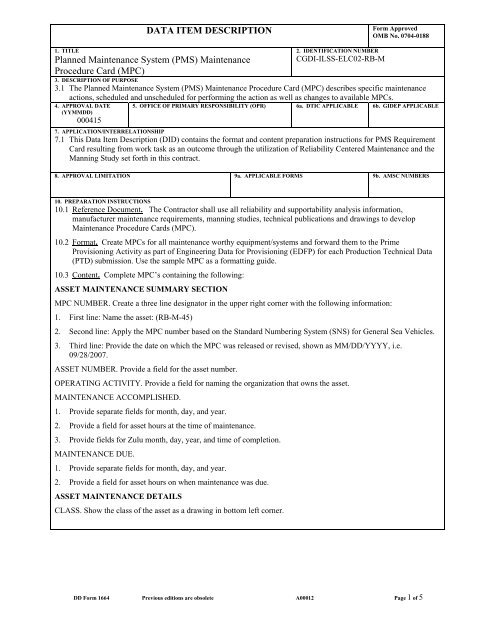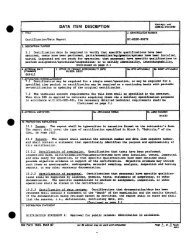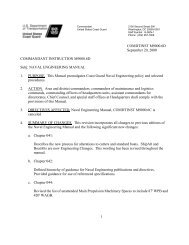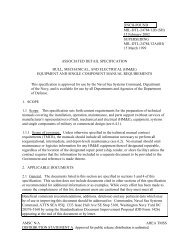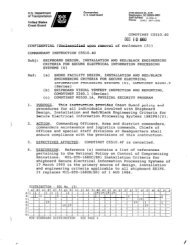(PMS) Maintenance Procedure Card
(PMS) Maintenance Procedure Card
(PMS) Maintenance Procedure Card
- No tags were found...
Create successful ePaper yourself
Turn your PDF publications into a flip-book with our unique Google optimized e-Paper software.
DATA ITEM DESCRIPTION<br />
Form Approved<br />
OMB No. 0704-0188<br />
1. TITLE<br />
Planned <strong>Maintenance</strong> System (<strong>PMS</strong>) <strong>Maintenance</strong><br />
<strong>Procedure</strong> <strong>Card</strong> (MPC)<br />
2. IDENTIFICATION NUMBER<br />
CGDI-ILSS-ELC02-RB-M<br />
3. DESCRIPTION OF PURPOSE<br />
3.1 The Planned <strong>Maintenance</strong> System (<strong>PMS</strong>) <strong>Maintenance</strong> <strong>Procedure</strong> <strong>Card</strong> (MPC) describes specific maintenance<br />
actions, scheduled and unscheduled for performing the action as well as changes to available MPCs.<br />
4. APPROVAL DATE<br />
(YYMMDD)<br />
000415<br />
5. OFFICE OF PRIMARY RESPONSIBILITY (OPR) 6a. DTIC APPLICABLE 6b. GIDEP APPLICABLE<br />
7. APPLICATION/INTERRELATIONSHIP<br />
7.1 This Data Item Description (DID) contains the format and content preparation instructions for <strong>PMS</strong> Requirement<br />
<strong>Card</strong> resulting from work task as an outcome through the utilization of Reliability Centered <strong>Maintenance</strong> and the<br />
Manning Study set forth in this contract.<br />
8. APPROVAL LIMITATION 9a. APPLICABLE FORMS 9b. AMSC NUMBERS<br />
10. PREPARATION INSTRUCTIONS<br />
10.1 Reference Document. The Contractor shall use all reliability and supportability analysis information,<br />
manufacturer maintenance requirements, manning studies, technical publications and drawings to develop<br />
<strong>Maintenance</strong> <strong>Procedure</strong> <strong>Card</strong>s (MPC).<br />
10.2 Format. Create MPCs for all maintenance worthy equipment/systems and forward them to the Prime<br />
Provisioning Activity as part of Engineering Data for Provisioning (EDFP) for each Production Technical Data<br />
(PTD) submission. Use the sample MPC as a formatting guide.<br />
10.3 Content. Complete MPC’s containing the following:<br />
ASSET MAINTENANCE SUMMARY SECTION<br />
MPC NUMBER. Create a three line designator in the upper right corner with the following information:<br />
1. First line: Name the asset: (RB-M-45)<br />
2. Second line: Apply the MPC number based on the Standard Numbering System (SNS) for General Sea Vehicles.<br />
3. Third line: Provide the date on which the MPC was released or revised, shown as MM/DD/YYYY, i.e.<br />
09/28/2007.<br />
ASSET NUMBER. Provide a field for the asset number.<br />
OPERATING ACTIVITY. Provide a field for naming the organization that owns the asset.<br />
MAINTENANCE ACCOMPLISHED.<br />
1. Provide separate fields for month, day, and year.<br />
2. Provide a field for asset hours at the time of maintenance.<br />
3. Provide fields for Zulu month, day, year, and time of completion.<br />
MAINTENANCE DUE.<br />
1. Provide separate fields for month, day, and year.<br />
2. Provide a field for asset hours on when maintenance was due.<br />
ASSET MAINTENANCE DETAILS<br />
CLASS. Show the class of the asset as a drawing in bottom left corner.<br />
DD Form 1664 Previous editions are obsolete A00012 Page 1 of 5
10. PREPARATION INSTRUCTIONS<br />
DUE. Provide a check box to indicate whether an action is due.<br />
CMS CODE. Provide a field for the CMS Code. The CMS Code identifies the component being maintained. For<br />
example, CMS CODE A53009 - Identifies the fuel system component affected by the maintenance task. The CMS<br />
CODE does not have to be the same as the MPC number; this allows the use of the same tasks on multiple MPCs<br />
and/or describes maintenance requirements in greater detail. There may be more than one CMS Code for each MPC.<br />
ACTION.<br />
1. A single word name of the maintenance action to be performed and on what equipment.<br />
2. Capitalize all letters of each word.<br />
3. Limit choices of actions to (a detailed description of each action is outlined in ECP-009):<br />
ADJUST INSP/CHK REM/INST<br />
AUDIT INSP/CLN REPAIR<br />
BULLETIN INSPECT REPLACE<br />
CALIBRATE INSTALL REPORT<br />
CHECK LIFE/LMTD SPCL/INSP<br />
CHECK/SERVICE LUBE SERVICE<br />
CONVERSION MODIFY TEST<br />
DEPOT/REPAIR NDI TEST/CHECK<br />
FIT TEST OVERHAUL WASH<br />
INSP/ACCPT REMOVE WEIGH<br />
DESCRIPTION.<br />
1. Provide the noun name of the equipment to be serviced, such as: FIXED C02 SYSTEM. Only one line item is<br />
allowed per MPC.<br />
2. Some activities may be used in lieu of noun name, i.e. WEEKLY INSPECTION<br />
3. Include the hour requirement in parentheses behind noun name (i.e. 100hr, 300hr, 1200hr) if the event is based on<br />
hours. Include first letter of the periodicity if event is based on calendar schedule (i.e. A = annually, S = Semiannually,<br />
Q = Quarterly, M = monthly, W = weekly).<br />
4. Capitalize all letters of each word.<br />
CEINUM. Provide a field for the CEINUM. The Component End Item Number (CEINUM) defines the configuration<br />
of the system, sub-system, sub-sub-system being maintained. The CEINUM is 9 characters separated by dashes as<br />
follows:<br />
• The 1 st two characters (prefix) identify the Platform; (RM)<br />
• The 2 nd set of 4 characters is generated from the applicable SNS table, (system/sub-system).<br />
• The final 3 characters are unique identifiers (sub-sub-system). For example:<br />
o CEINUM RM-A000-001<br />
• RM = Platform Type (RB-M 45’ Boat)<br />
• A0 = System (Hull)<br />
• 00 = Sub-system (General)<br />
• 001 = Unique Identifier<br />
SERIAL NUMBER. Provide a field for recording the serial number if the asset is a serial number-tracked asset.<br />
SCHEDULED / UNSCHEDULED. Provide check boxes for indicating a scheduled or unscheduled maintenance<br />
action.<br />
DISCREPANCIES FOUND. Provide YES/NO places for check marks.<br />
MAN-HOURS.<br />
1. Provide fields for recording the actual number of man-hours expended to accomplish the job.<br />
DD Form 1664 Previous editions are obsolete A00012 Page 2 of 5
2. List the rates qualified to perform the maintenance action. Format in bold font the rate most qualified to perform<br />
the action.<br />
3. Include a space with each rate for entering actual man-hours used to perform maintenance task.<br />
REMARKS. Provide a field of two lines for recording discrepancies.<br />
TECHNICIAN’S SIGNATURE / ID. Provide separate fields for the technician’s signature and ID.<br />
QA. Provide ten fields for Quality Assurance (QA) initials to record QA checks.<br />
RELATED MAINTENANCE<br />
1. Provide the bottom one-fourth of the MPC as a field for related MPCs.<br />
2. List related MPCs that can be updated as a result of the current maintenance action.<br />
3. List references used to write this MPC. If no references were used, write the word NONE.<br />
ASSET MAINTENANCE PROCEDURES<br />
Write asset maintenance procedures so the MPC can be used as a standalone document by technicians and not require<br />
additional reference material.<br />
MPC DESCRIPTION AND ACTION. This is Item 1 of the procedures (see paragraph layout later in this section) and<br />
leads off the text portion of the MPC. Provide the MPC title and action together.<br />
REFERENCES.<br />
1. Although the MPC is a standalone document, there may be situations when technicians encounter a situation for<br />
which they need additional references. List relevant references at the beginning of the procedures section in alphanumeric<br />
order like applicable technical manuals, field changes, publications, etc. to assist in completion of the<br />
MPC.<br />
2. Indent the reference name ½ inch under the section title. Capitalize all letters of the section title: REFERENCES.<br />
Capitalize the first letter of each word of the reference name, excluding conjunctions. If there are no references,<br />
print the word NONE.<br />
TOOLS/TEST EQUIPMENT.<br />
1. Use this entry to save time and effort for those performing the maintenance procedure by reminding them of any<br />
special tools and/or equipment required to accomplish the job. Do not list common tools normally contained in a<br />
standard toolbox. Only portable and non-installed equipment to perform the maintenance procedure shall be listed.<br />
2. When fabrication of a special tool is required, specifications will be noted in either the maintenance procedure,<br />
reference or both.<br />
3. Each entry shall consist of one item only i.e. if an oiler with MIL-PRF-6086E oil is required, the oiler will be<br />
listed in tools and the oil listed under consumables. Capitalize all letters of the section title: TOOLS/TEST<br />
EQUIPMENT. First letter of each word of the tool/test equipment name, excluding conjunctions, shall be<br />
capitalized. If no tools or test equipment are required in the text, print the word NONE.<br />
EXPENDABLES.<br />
1. Parts required to perform the MPC only. This does not include corrective maintenance parts. Parts are any item<br />
which is an integral part of the equipment; i.e. gaskets, seals, filters etc. In general, any item listed in a technical<br />
manual or drawing parts listing is considered a repair part. An official definition of a repair part is any item<br />
appearing on the Master Equipment Configuration List (MECL). Although in some cases repair parts will not<br />
appear on the MECL, this does not necessarily mean the item is not a repair part. In fact, it is a good indication<br />
the MECL may be technically deficient in that it does not list all maintenance significant repair parts. Repair parts<br />
are probably the most critical of all requirements. A MPC requiring parts cannot be effectively completed unless<br />
those parts are readily available from onboard supply department stock.<br />
DD Form 1664 Previous editions are obsolete A00012 Page 3 of 5
2. The MECL is the primary source for identifying <strong>PMS</strong> repair part requirements to the supply system.<br />
3. Include part number, NSN/FSN, cage codes, etc., when available. Capitalize all letters of the section title:<br />
EXPENDABLES. First letter of each term, excluding conjunctions, shall be capitalized. If no expendables are<br />
required in the text, print the word NONE.<br />
CONSUMABLES.<br />
1. Rags, wire, lubricants, greases, solvents, miscellaneous hardware, tape, cleaning supplies, etc. that are used when<br />
performing this MPC.<br />
Include part number, National Stock Number (NSN) / Federal Stock Number (FSN), cage codes, etc., when available.<br />
Capitalize all letters of the section title: TOOLS/TEST EQUIPMENT. First letter of each term, excluding<br />
conjunctions, shall be capitalized. If no consumables are required in the text, print the word NONE.<br />
MAINTENANCE PROCEDURE TEXT.<br />
1. Provide text that defines the scope of the maintenance procedure and guides the individual performing that<br />
procedure through a step-by-step sequence. To keep the system simple and workable, write the text for use<br />
by personnel trained to the level indicated in the MPC.<br />
2. Provide sufficient detail to permit the average Petty Officer to accomplish the task directly or with minimal<br />
supervision and/or reference to technical manuals. For inexperienced personnel, the procedures shall be<br />
suitable pre-work training aids.<br />
3. Integrate warnings, cautions, and notes into the steps of the maintenance procedures at the point where they<br />
should be observed. Warnings, cautions, and notes will precede the maintenance steps. See the format for<br />
warnings, cautions, and notes later in this section.<br />
a. Warnings and cautions provide special safety procedures for workers to observe and perform.<br />
b. Include Hazardous Material that may pose a special threat to personnel and/or require special<br />
handling or disposal procedures. May be same line item as a consumable or part. Include part<br />
number or NSN/FSN, when available.<br />
c. Do not include routine safety practices that should be observed in all engineering or maintenance<br />
applications. Do not include phrases like, "Observe standard safety practices," since standard safety<br />
practices are, by their nature, always required i.e. System has two power supply sources; Avoid<br />
prolonged contact with, or inhalation of, cleaning solvents; Avoid use near heat or open flame and<br />
provide adequate ventilation.<br />
d. Notes supply needed information that is not an action step. Avoid excessive verbiage shall and limit<br />
the note to necessary specifics. Do not give tolerances and clearances as notes but as part of the<br />
procedural step in which they are observed. The word note shall be capitalized, bolded with a colon<br />
i.e. NOTE:. Each note paragraph shall be double-spaced before and after the text, as to stand out<br />
and attract attention.<br />
4. Separate paragraphs with an additional line of space to ensure they stand out and attract attention.<br />
5. Insert graphics at appropriate points in the text to illustrate the work to be done.<br />
6. The use of standard phrases within the <strong>PMS</strong> Template shall be entered as steps i.e. tag out, clear tag, hazwaste<br />
disposal, etc.<br />
7. Each procedure step is identified numerically and sub-steps alphabetically with standard indent. Indent the<br />
paragraphs this way:<br />
1 (ITEM) Level 1 Task description<br />
A (PARAGRAPH) Level 2 Title of action (REMOVE, INSPECT, etc.)<br />
1. (STEP) Level 3 Text<br />
a. Substep Level 4<br />
(1) Substep Level 5<br />
(a) Substep Level 6<br />
1)Substep Level 7<br />
a) Substep Level 8<br />
DD Form 1664 Previous editions are obsolete A00012 Page 4 of 5
Insert warnings, cautions, and notes in the relevant locations of the text where they should appear. List<br />
warnings, cautions, and notes in this order:<br />
WARNINGS<br />
THE WARNING COMPONENT SHOULD NOT BE SEPARATED FROM THE WARNING<br />
HEADING. IT SHOULD NOT BE SPLIT AND IT SHOULD NOT END A PAGE. AN EXCEPTION<br />
IS WHEN A LENGTHY WARNING, WILL CAUSE MORE THAN A THIRD OF THE PAGE TO BE<br />
LEFT BLANK DUE TO REFERENCED STEP ROLLING TO THE NEXT PAGE. THE WARNING<br />
CAN END A PAGE AND THE FIRST STEP OR TEXT FOLLOWING THE WARNING MUST<br />
APPEAR IMMEDIATELY ON THE NEXT PAGE.<br />
CAUTIONS<br />
THIS IS THE CAUTION COMPONENT. IT SHOULD NOT BE SEPARATED FROM THE CAUTION<br />
HEADING. IT SHOULD NOT BE SPLIT AND IT SHOULD NOT END A PAGE. AN EXCEPTION IS<br />
WHEN A LENGTHY CAUTION WILL CAUSE MORE THAN A THIRD OF THE PAGE TO BE LEFT<br />
BLANK DUE REFERENCED STEP ROLLING TO THE NEXT PAGE, THE CAUTION CAN END A<br />
PAGE AND THE FIRST STEP OR TEXT FOLLOWING THE CAUTION MUST APPEAR<br />
IMMEDIATELY ON THE NEXT PAGE.<br />
NOTE: This component is used for notes. Notes should precede the step that they are emphasizing.<br />
Excessive white space is the determining factor. MPCs with a conditional periodicity may have notes.<br />
PREVENTIVE MAINTENANCE CARD TEMPLATE: The Contractor shall construct the MPCs in the following<br />
Government provided Word format template files.<br />
DD Form 1664 Previous editions are obsolete A00012 Page 5 of 5


